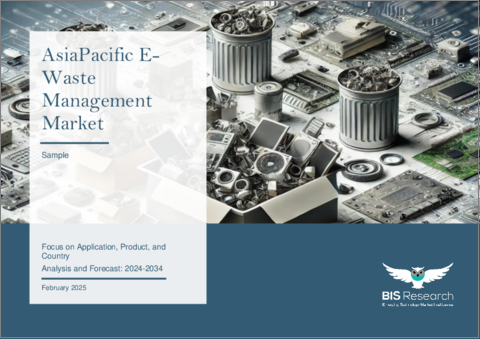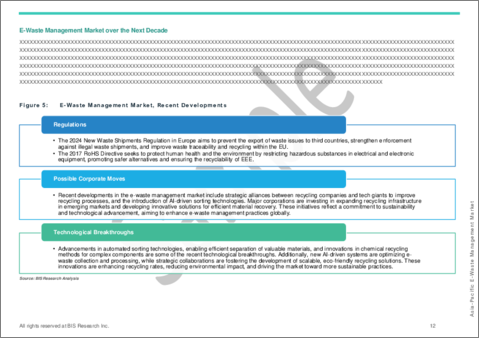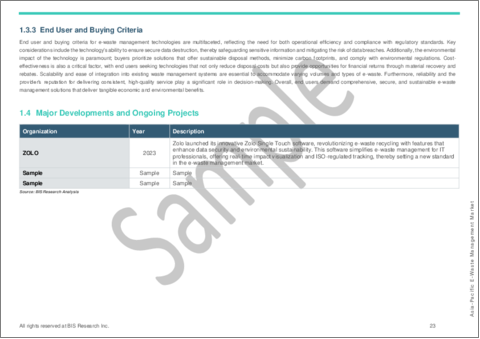|
|
市場調査レポート
商品コード
1668772
アジア太平洋の電子廃棄物管理市場:用途別、製品別、国別 - 分析と予測(2024年~2034年)Asia-Pacific E-Waste Management Market: Focus on Application, Product, and Country - Analysis and Forecast, 2024-2034 |
||||||
カスタマイズ可能
|
|||||||
| アジア太平洋の電子廃棄物管理市場:用途別、製品別、国別 - 分析と予測(2024年~2034年) |
|
出版日: 2025年03月05日
発行: BIS Research
ページ情報: 英文 64 Pages
納期: 1~5営業日
|
全表示
- 概要
- 図表
- 目次
アジア太平洋の電子廃棄物管理の市場規模は、2024年の42億米ドルから2034年には167億8,000万米ドルに達し、予測期間の2024年~2034年のCAGRは14.84%になると予測されています。
リサイクルの効率は、自動選別や洗練された回収手順などの技術革新によって向上しており、この地域では、持続可能性に対する企業や消費者の関心の高まりによって、効率的な電子廃棄物管理ソリューションの採用が加速しています。規制の強化、持続可能性に対する意識の高まり、有害廃棄物の安全な処理という差し迫ったニーズにより、アジア太平洋の電子廃棄物管理市場は大きく成長すると予想されます。
| 主要市場統計 | |
|---|---|
| 予測期間 | 2024年~2034年 |
| 2024年評価 | 42億米ドル |
| 2034年予測 | 167億8,000万米ドル |
| CAGR | 14.84% |
アジア太平洋における電子廃棄物管理市場は、製品ライフサイクルの短縮、環境問題の高まり、電子機器消費の増加などの要因により、急速に拡大しています。アジア太平洋は電子機器の生産と消費の主要な中心地であるため、多くの電子廃棄物が発生し、効果的なリサイクルと廃棄方法が求められています。アジア太平洋の各国政府は、持続可能性、リサイクル、電子廃棄物回収の取り組みを強化するため、拡大生産者責任(EPR)ガイドラインのような、より厳格な法律を施行しつつあります。
自動選別システム、人工知能(AI)による材料回収、より優れたリサイクルインフラは、処理効率を高める技術革新のほんの一例に過ぎません。再利用や再生も、電子廃棄物の総排出量を削減する循環経済技術の利用拡大によって奨励されています。持続可能な廃棄物管理への移行は、中国、インド、日本、韓国などの国々が、政府主導のプログラムや民間セクターの協力を通じて主導しています。
このような進歩にもかかわらず、回収のための不十分なネットワーク、不法投棄、法外なリサイクル費用などの問題は依然として存在しています。前向きな変化は、最先端のリサイクル技術への投資、企業の持続可能性の誓約、消費者の意識の高まりによって促進されています。
アジア太平洋の電子廃棄物管理市場は、法律の強化、リサイクル技術の向上、環境に配慮した実践と持続可能な資源回収の重視の高まりにより、大きく成長すると予想されます。
当レポートでは、アジア太平洋の電子廃棄物管理市場について調査し、市場の概要とともに、用途別、製品別、国別の動向、および市場に参入する企業のプロファイルなどを提供しています。
目次
エグゼクティブサマリー
第1章 市場
- 動向:現在および将来の影響評価
- サプライチェーンの概要
- 研究開発レビュー
- 規制状況
- ステークホルダー分析
- 主な開発と進行中のプロジェクト
- 市場力学:概要
第2章 地域
- 電子廃棄物管理市場(地域別)
- 地域別概要
- アジア太平洋
- 市場
- 用途
- 製品
- アジア太平洋(国別)
第3章 市場-競合ベンチマーキングと企業プロファイル
- 今後の見通し
- 企業プロファイル
- ENVIRO HUB HOLDINGS PTE LTD
- SK tes
- Sembcorp Industries
第4章 調査手法
List of Figures
- Figure 1: Asia-Pacific E-Waste Management Market (by Application), 2023, 2027, and 2034
- Figure 2: Asia-Pacific E-Waste Management Market (by Material), 2023, 2027, and 2033
- Figure 3: Asia-Pacific E-Waste Management Market (by Source), 2023, 2027, and 2033
- Figure 4: Recycled Amount vs. Value Contained in the Recycled E-Waste (2019-2023)
- Figure 5: E-Waste Management Market, Recent Developments
- Figure 6: Supply Chain and Risks within the Supply Chain
- Figure 7: Value Chain
- Figure 8: Pricing Analysis of E-Waste Management Market, 2023-2034
- Figure 9: Patent Analysis (by Country), 2021-2024
- Figure 10: Patent Analysis (by Company), January 2021-December 2023
- Figure 11: Maximizing Value from End-of-Life Technology for Grab
- Figure 12: Circular Economy Approaches for the Electronics Sector in Nigeria
- Figure 13: Impact Analysis of Market Navigating Factors, 2024-2033
- Figure 14: E-Waste Generated, Million Ton, 2019-2023
- Figure 15: China E-Waste Management Market, $Million, 2023-2034
- Figure 16: Japan E-Waste Management Market, $Million, 2023-2034
- Figure 17: South Korea E-Waste Management Market, $Million, 2023-2034
- Figure 18: India E-Waste Management Market, $Million, 2023-2034
- Figure 19: Rest-of-Asia-Pacific E-Waste Management Market, $Million, 2023-2034
- Figure 20: Strategic Initiatives, 2021-2023
- Figure 21: Share of Strategic Initiatives, 2021-2024
- Figure 22: Data Triangulation
- Figure 23: Top-Down and Bottom-Up Approach
- Figure 24: Assumptions and Limitations
List of Tables
- Table 1: Market Snapshot
- Table 2: E-Waste Management Market, Opportunities
- Table 3: Trends: Current and Future Impact Assessment
- Table 4: E-Waste Management Market (by Region), $Million, 2023-2034
- Table 5: Asia-Pacific E-Waste Management Market (by Application), $Million, 2023-2034
- Table 6: Asia-Pacific E-Waste Management Market (by Material), $Million, 2023-2034
- Table 7: Asia-Pacific E-Waste Management Market (by Source), $Million, 2023-2034
- Table 8: China E-Waste Management Market (by Application), $Million, 2023-2034
- Table 9: China E-Waste Management Market (by Material), $Million, 2023-2034
- Table 10: China E-Waste Management Market (by Source), $Million, 2023-2034
- Table 11: Japan E-Waste Management Market (by Application), $Million, 2023-2034
- Table 12: Japan E-Waste Management Market (by Material), $Million, 2023-2034
- Table 13: Japan E-Waste Management Market (by Source), $Million, 2023-2034
- Table 14: South Korea E-Waste Management Market (by Application), $Million, 2023-2034
- Table 15: South Korea E-Waste Management Market (by Material), $Million, 2023-2034
- Table 16: South Korea E-Waste Management Market (by Source), $Million, 2023-2034
- Table 17: India E-Waste Management Market (by Application), $Million, 2023-2034
- Table 18: India E-Waste Management Market (by Material), $Million, 2023-2034
- Table 19: India E-Waste Management Market (by Source), $Million, 2023-2034
- Table 20: Rest-of-Asia-Pacific E-Waste Management Market (by Application), $Million, 2023-2034
- Table 21: Rest-of-Asia-Pacific E-Waste Management Market (by Material), $Million, 2023-2034
- Table 22: Rest-of-Asia-Pacific E-Waste Management Market (by Source), $Million, 2023-2034
- Table 23: Market Share, 2023
Introduction to Asia-Pacific E-Waste Management Market
The Asia-Pacific E-Waste Management Market is projected to reach $16.78 billion by 2034 from $4.20 billion in 2024, growing at a CAGR of 14.84% during the forecast period 2024-2034. Efficiency in recycling is being improved by innovations like automated sorting and sophisticated recovery procedures, and the region's adoption of efficient e-waste management solutions is being accelerated by growing corporate and consumer attention to sustainability. Due to tighter regulations, growing awareness of sustainability, and the pressing need for safe disposal of hazardous waste, the APAC e-waste management market is expected to grow significantly.
Market Introduction
| KEY MARKET STATISTICS | |
|---|---|
| Forecast Period | 2024 - 2034 |
| 2024 Evaluation | $4.20 Billion |
| 2034 Forecast | $16.78 Billion |
| CAGR | 14.84% |
The market for managing e-waste in Asia-Pacific (APAC) is expanding quickly due to factors like shorter product life cycles, growing environmental concerns, and rising electronic consumption. Since APAC is a major centre for the production and consumption of electronics, the region produces a lot of e-waste, which calls for effective recycling and disposal methods. APAC governments are enforcing stricter laws, like Extended Producer Responsibility (EPR) guidelines, to enhance efforts at sustainability, recycling, and e-waste collection.
Automated sorting systems, material recovery powered by artificial intelligence (AI), and better recycling infrastructure are just a few examples of the technological innovations that are increasing processing efficiency. Reuse and refurbishment are also being encouraged by the increasing use of circular economy techniques, which lowers the total amount of e-waste produced. The transition to sustainable waste management is being spearheaded by nations like China, India, Japan, and South Korea through government-led programs and private sector collaborations.
Despite these advancements, problems like insufficient networks for collection, unlawful dumping, and exorbitant recycling expenses still exist. Positive change is being fuelled by investments in cutting-edge recycling technologies, corporate sustainability pledges, and growing consumer awareness.
All things considered, the APAC e-waste management market is expected to grow significantly due to stronger laws, improved recycling techniques, and an increasing emphasis on environmentally conscious practices and sustainable resource recovery.
Market Segmentation
Segmentation 1: by Application
- Recycled
- Trashed
Segmentation 2: by Material
- Metal
- Plastic
- Glass
- Others
Segmentation 3: by Source
- Industrial Appliances
- Household Appliances
- Consumer Electronics
Segmentation 4: by Country
- China
- Japan
- South Korea
- India
- Rest-of-Asia-Pacific
How can this report add value to an organization?
Product/Innovation Strategy: This report provides a comprehensive product/innovation strategy for the Asia-Pacific e-waste management market, identifying opportunities for market entry, technology adoption, and sustainable growth. It offers actionable insights, helping organizations leverage e-waste management to meet environmental standards, gain a competitive edge, and capitalize on the increasing demand for eco-friendly solutions in various industries.
Growth/Marketing Strategy: This report offers a comprehensive growth and marketing strategy designed specifically for the Asia-Pacific e-waste management market. It presents a targeted approach to identifying specialized market segments, establishing a competitive advantage, and implementing creative marketing initiatives aimed at optimizing market share and financial performance. By harnessing these strategic recommendations, organizations can elevate their market presence, seize emerging prospects, and efficiently propel revenue expansion.
Competitive Strategy: This report crafts a strong competitive strategy tailored to the Asia-Pacific e-waste management market. It evaluates market rivals, suggests methods to stand out, and offers guidance for maintaining a competitive edge. By adhering to these strategic directives, companies can position themselves effectively in the face of market competition, ensuring sustained prosperity and profitability.
Key Market Players and Competition Synopsis
The companies that are profiled in the report have been selected based on input gathered from primary experts and analyzing company coverage, product portfolio, and market penetration.
Some of the prominent names in this market are:
- ENVIRO HUB HOLDINGS PTE LTD
- SK tes
- Sembcorp Industries
Table of Contents
Executive Summary
Scope and Definition
1 Market
- 1.1 Trends: Current and Future Impact Assessment
- 1.1.1 Growing Government Regulations toward E-Waste Management
- 1.1.2 Investments in E-Waste Recycling Infrastructure
- 1.2 Supply Chain Overview
- 1.2.1 Value Chain Analysis
- 1.2.2 Market Map
- 1.2.2.1 E-Waste Management Market (by Material)
- 1.2.2.1.1 Metal
- 1.2.2.1.2 Plastic
- 1.2.2.1.3 Glass
- 1.2.2.1.4 Others
- 1.2.2.1 E-Waste Management Market (by Material)
- 1.2.3 Pricing Forecast
- 1.3 Research and Development Review
- 1.3.1 Patent Filing Trend (by Country)
- 1.4 Regulatory Landscape
- 1.4.1 Consortiums and Associations
- 1.4.2 Regulations
- 1.5 Stakeholder Analysis
- 1.5.1 Use Cases
- 1.5.2 End User and Buying Criteria
- 1.6 Major Developments and Ongoing Projects
- 1.7 Market Dynamics: Overview
- 1.7.1 Market Drivers
- 1.7.1.1 Increasing E-Waste Generation
- 1.7.1.2 Rising Awareness of E-Waste as a Hazard
- 1.7.1.3 Shift toward Circular Economy
- 1.7.2 Market Restraints
- 1.7.2.1 High Recycling Cost
- 1.7.2.2 Limited Recycling Infrastructure
- 1.7.3 Market Opportunities
- 1.7.3.1 Advancements in Recycling Technologies
- 1.7.3.2 Growing Adoption of Secondary Metals in Electronics, Jewelry, and Automotive Industries
- 1.7.1 Market Drivers
2 Region
- 2.1 E-Waste Management Market (by Region)
- 2.1.1 Regional Summary
- 2.2 Asia-Pacific
- 2.2.1 Market
- 2.2.1.1 Business Drivers
- 2.2.1.2 Business Challenges
- 2.2.2 Application
- 2.2.2.1 Application
- 2.2.3 Product
- 2.2.4 Asia-Pacific (by Country)
- 2.2.4.1 China
- 2.2.4.1.1 Application
- 2.2.4.1.2 Product
- 2.2.4.2 Japan
- 2.2.4.2.1 Application
- 2.2.4.2.2 Product
- 2.2.4.3 South Korea
- 2.2.4.3.1 Application
- 2.2.4.3.2 Product
- 2.2.4.4 India
- 2.2.4.4.1 Application
- 2.2.4.4.2 Product
- 2.2.4.5 Rest-of-Asia-Pacific
- 2.2.4.5.1 Application
- 2.2.4.5.2 Product
- 2.2.4.1 China
- 2.2.1 Market
3 Markets - Competitive Benchmarking & Company Profiles
- 3.1 Next Frontiers
- 3.2 Company Profiles
- 3.2.1 ENVIRO HUB HOLDINGS PTE LTD
- 3.2.1.1 Overview
- 3.2.1.2 Product Portfolio
- 3.2.1.3 Top Competitors
- 3.2.1.4 Target Customers/End-Use Industries
- 3.2.1.5 Key Personnel
- 3.2.1.6 Analyst View
- 3.2.1.7 Market Share, 2023
- 3.2.2 SK tes
- 3.2.2.1 Overview
- 3.2.2.2 Product Portfolio
- 3.2.2.3 Top Competitors
- 3.2.2.4 Target Customers/End-Use Industries
- 3.2.2.5 Key Personnel
- 3.2.2.6 Analyst View
- 3.2.2.7 Market Share, 2023
- 3.2.3 Sembcorp Industries
- 3.2.3.1 Overview
- 3.2.3.2 Product Portfolio
- 3.2.3.3 Top Competitors
- 3.2.3.4 Target Customers/End-Use Industries
- 3.2.3.5 Key Personnel
- 3.2.3.6 Analyst View
- 3.2.3.7 Market Share, 2023
- 3.2.1 ENVIRO HUB HOLDINGS PTE LTD
4 Research Methodology
- 4.1 Data Sources
- 4.1.1 Primary Data Sources
- 4.1.2 Secondary Data Sources
- 4.1.3 Data Triangulation
- 4.2 Market Estimation and Forecast






